Last week I explored the Victorian croquet craze and the role that flirtation played in the game’s quick rise in popularity. Young men and women delighted in the opportunity for casual socializing and flocked to lawns around England and America to interact. It lost as many fans as it gained, however, with many losing their tempers and with women developing a propensity for cheating at the game. So, in the absence of a croquet mallet, how did Victorians express interest in the opposite sex? Given the popularity of the game, it is clear that flirting was very much on the minds of people from all backgrounds, but as we know, strict societal rules were in place that imposed limitations on courtship. I originally became interested in how a woman may use the popular accessories of the time to amplify her coy-factor and what I discovered is an entire industry of flirting-related products being sold at the time. The most popular, or at least the one that seems to have the most current day interest is the language of the fan. Once you see how complex such flirting was, you’ll probably be very glad for simple texting and direct conversation!
Flirting by hand fan
One of the most fashionable accessories used in Victorian flirting was the hand fan. Not only could a woman bring attention to her eyes and face by how she placed her fan, but they were also delicate and feminine items. They were also necessary in the time before air conditioning and no proper lady was ever without one. As it became more acceptable for women to play a part in the courtship process, fan makers seized the opportunity to involve their accessories in some innocent flirting.
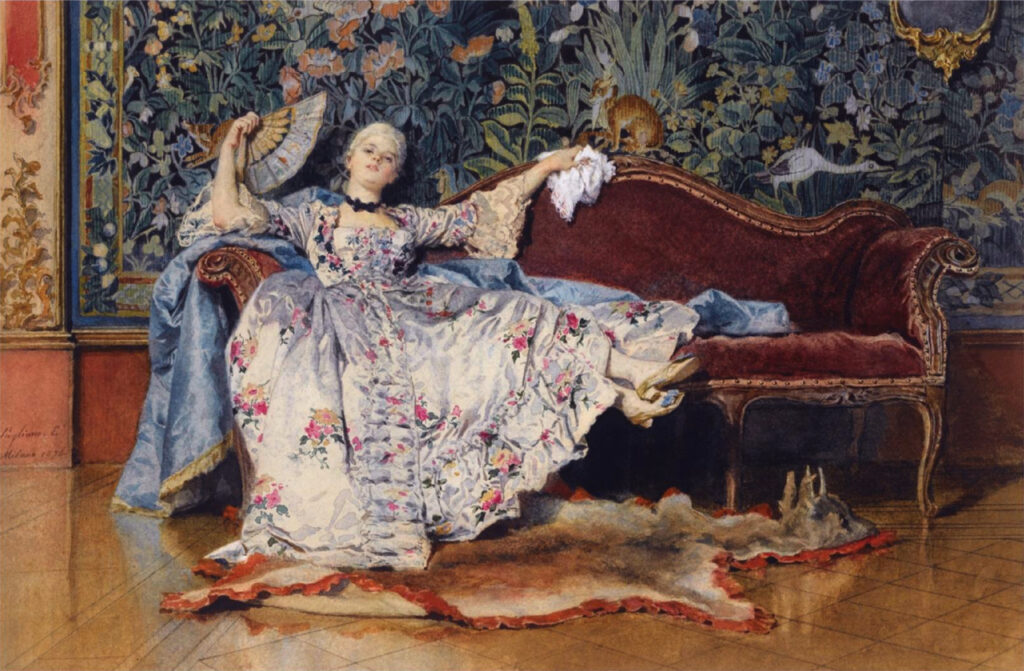
The first way that a fan was utilized to send a discrete message to an observing gentleman was in the way a woman held it. For instance, holding a fan in the left hand while holding it in front of the face would signal to the onlooker that you desired an acquaintance. Dozens of signals were developed to appease the need for communication in a public space in an age where direct speech was considered too forward. Such a game was similar to that of the language of flowers that I discussed in one of my A Very British Romance posts.
So, how did one learn to speak or decipher the language of the hand fan? This is where the onslaught of products came into play. Pamphlets, books, cards, and other instructional materials were sold, especially enjoyed by young Victorian ladies. Such materials were often sold by fan designers themselves. French fan maker and leather goods producer Duvelleroy, for instance, became quite well known after publishing an entire book on the art of fan flirting, along with a short guide included with each fan purchase.
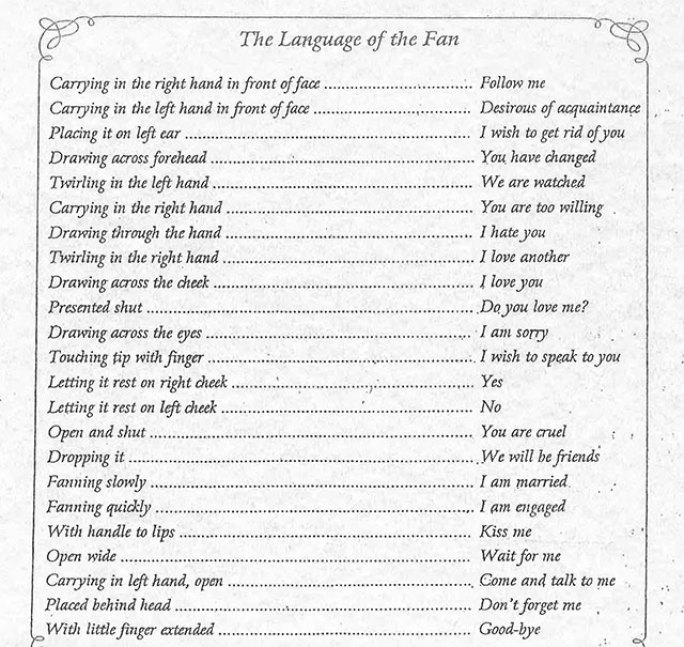
Some of my favorite fan messages from Duvelleroy include:
Carrying in right hang in front of the face: Follow me
Place it on the left ear: I wish to get rid of you
Carrying in the right hand: You are too willing
With handle to lips: Kiss me
Placed behind head: Don’t forget me
Touching tip with finger: I wish to speak to you
So much for just using a fan for the practical purpose of keeping cool!
The language of the fan and the language of flowers seem to have been the trendiest ways of complicatedly and properly communicating with the opposite sex, though the trend extended to other accessories. I have come across calling card flirting, parasol flirting, handkerchief flirting, glove flirting, and even a reference to a cigar flirting experiment.
Fan flirting 2.0: Decipher the code
The second way to flirt via fan was to purchase a fan made for that very purpose. The Ladies Conversation Fan, for instance, was essentially a fancy morse code instrument in which an elaborate pattern of tapping on elbows would produce the desired message to a suitor. The method was as follows:
Position 1: Hold fan in left hand and touch the right arm = letters A – E
Position 2: Hold fan in right hand and touch the left arm = letters F – K
Position 3: Place the fan against the heart = letters L – P
Position 4: Raise the fan to mouth = letters Q – U
Position 5: Raise the fan to forehead = letters V – Z
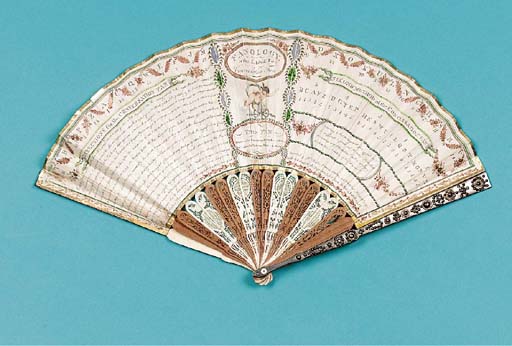
You would then use the same motions to indicate which number of the letter in each combination. So for example, if you wanted to spell S.O.S, for the letter S you would place your fan in position 4 and then place it in position 3, for the letter O, position 3 then position 4 and for S again, position 4 then position 3 (taken from Owlcation.com).
Imagine a society in which speaking directly was so improper that such behavior would seem even the slightest bit plausible or necessary!
On the other hand, The Ladies Telegraph fan was made with each letter of the alphabet printed on the flaps of the fan. If a woman suspected that she was being pursued by someone in close proximity, she needed to only point to each letter of the (hopefully short) message she intended to send. This seems reasonable in comparison.
I love hand fans and regularly use them, but I’ll take texting and face to face conversation over this complexity any day!
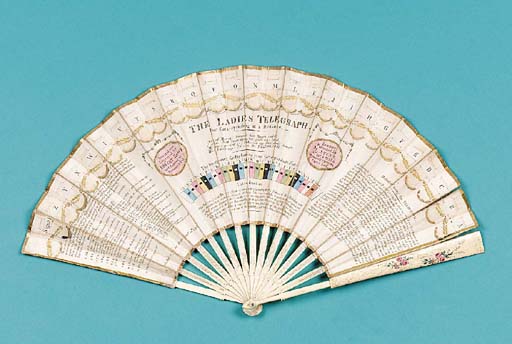
Learning the language of the fan
You may be wondering how Victorians ever managed to keep track of so many signals, codes, and languages. As a fan of the secret language of flowers, I have wondered this myself. It is true that a hand fan is an excellent tool for a woman who wants to indulge in a bit of flirting. The act of holding it across the face while sending a friendly glace across the room to a potential suitor is compelling in and of itself. That Victorian women utilized the various languages available or that men took it upon themselves to learn the codes, however, is unlikely. They were clever ways of marketing fans, were popular items, and probably a bit of a status symbol to have (I myself would love to get my hands on any of the items mentioned in this post). But the coded fans and the translation materials were likely novelty items that people enjoyed having and nothing more. This is evidenced by many things including the lack of reference to fan flirting in popular literature of the time.
Other rules of fan etiquette
When it came to hand fans in Victorian times, there was more to keep in mind than whether or not you were sending a message to someone across the room. Etiquette manuals of the time referred to fans and their proper use. For instance, The Ladies’ Book of Etiquette, and Manual for Politeness from 1872 makes sure to let ladies know that when attending the theater they should not do anything to attract attention, including attempting to flirt via a fan.
Other standards of the time include:
-A proper hostess should have a fan waiting in the bathroom of a female guest.
-Giving simple but thoughtful gifts to an object of affection was considered an appropriate move on the part of a Victorian gentleman, but it was imperative to get it right. The 1890 manual Manners, Culture, and Dress of the Best American Society reads: “When a gentleman presents a fan, flower, or trinket to a lady with the left hand, this on his part is an overture of regard; should she receive it with the left hand, it is considered as an acceptance of his esteem; but if with the right hand, it is a refusal of the offer.”
-Attending a ball well equipped was “essential” according to the Ladies Book of Etiquette. A proper woman would have had with her fancy kid gloves, a “fine-timmed” handkerchief, and of course, a fan.
-A fan was considered an appropriate gift for a bride to give to a bridesmaid. Likewise, it was considered more appropriate to ask a bridesmaid to carry a hand fan or a basket of flowers over a bouquet during the wedding.
-And of course, one must have been careful to select the fan to accompany one’s outfit with the highest level of discernment. The Art of Dressing Well: A Complete Guide to Economy, Style and Propriety warns women that “A fan of color discordant with the prevailing color of the dress, will destroy the beauty of a most elaborate toilet; and a pair of ill-fitting or ill-matched gloves with be quite as bad.”
But this isn’t all to keep in mind. Given the popularity of the fan, more needed to be said. “Fans for evening use are now furnished in such exquisite taste and variety, that it seems almost superfluous to mention them; yet they are so often carried to the utter ruin of the dress, that we venture a word. If the purse will not allow of a fan for each toilet, let a lady provide one of white–feathers are the handsomest–and one of black lace over black silk. The first is adapted to any light evening-dress, while the latter will better suit the warmer colors or more sober hues. A dress of black velvet or lack is indeed often improved by a fan of white or gay-colored feathers; but the taste that will guide the whole dress should also be exercised in the selected of this ornament. It is often a valuable as well as a handsome addition to a lady’s wardrobe, and can scarcely be dispensed with in an evening toilet.”
In other words, if you are on a budget, start with a white and a black fan, but for the love of all that is proper, make sure that the color AND fabric pair well with what you are wearing.

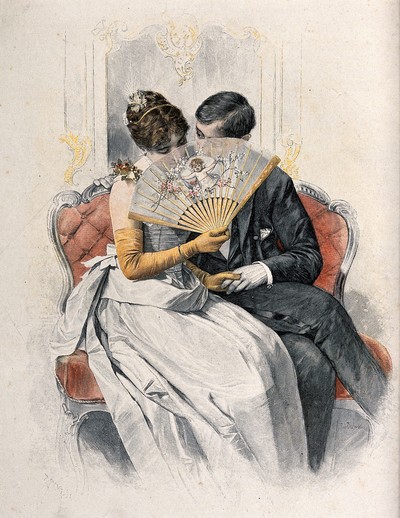












Thank you for this article, I enjoy your work.
Ladies finishing schools and other higher refined educational systems taught “fan.”
Fan use during the Civil War had many valuable uses, and held many a messages, maps, items, etc, inside the fans actual skeletal construction (outside alone could be worked: carved design, scroll work, lettering applied, decorated, hollow core, etc). One could get creative with the outside layer of fan, and in the several layers of what material was used- what was on it or hidden in it. Fans were used as a plain in sight delivery system with the use and of its own determined cause, whether for cooling oneself or misplacing it when out and about or, “lending” passing, returning to another person, or using as a weapon to defend oneself.